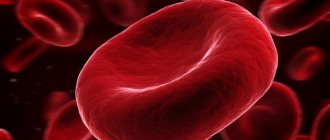Analysis number in the Science database: 131.
Alkaline phosphatase (ALP) is an enzyme belonging to the class of hydrolases that catalyzes the dephosphorylation reaction of many types of molecules, such as nucleotides, proteins and alkaloids. In humans, ALP is present in small quantities in all tissues, but especially high concentrations in the liver, bile duct, kidneys, bones and placenta. Other isoenzymes are also found:
- ALPI - intestinal,
- ALPL - nonspecific in liver, bone and kidney tissues;
- ALPP - placental.
Description
Alkaline phosphatase is present in high concentrations in the liver, bone tissue, placenta and intestinal epithelium. Each of these tissues contains specific ALP isoenzymes. A pathological increase in alkaline phosphatase activity is observed most often in cholestatic liver disease and bone diseases in which the activity of osteoblasts increases, such as Paget's disease and osteomalacia. A physiological increase in ALP activity is observed during pregnancy (due to the placental isoform of the enzyme) and in childhood, when bone growth occurs (due to the bone isoenzyme). Plasma concentrations of the enzyme are high at birth but fall rapidly thereafter. However, during childhood it remains 2–3 times higher than normal adult levels. Enzyme activity increases again during adolescence before declining to adult levels as bone growth ceases (Figure 1).
Rice. 1 — Dependence of alkaline phosphatase activity in blood serum on the age of the child. Average values shown; Peaks between 10 and 16 years of age correspond to accelerated growth during maturation and may be more than 3 times the upper normal limit for adults
The activity of alkaline phosphatase in the blood plasma of practically healthy elderly people is slightly higher than normal. This may be explained by the high incidence of mild subclinical Paget's disease in older people. ALP concentrations greater than 10 times the upper limit of normal may occur in severe Paget's disease, rickets and osteomalacia, and occasionally in cholestatic liver disease. However, these conditions are more characterized by a smaller increase in activity. ALP activity does not increase in osteoporosis unless the condition is complicated by bone collapse or fracture.
The concentration of ALP in the blood plasma usually increases with the development of malignant neoplasms of bone or liver origin, and can be associated with both primary and secondary tumors localized in these tissues. A number of tumor-specific forms of ALP, which are secreted by the tumor cells themselves, have also been described. The best known of these is the Regan isoenzyme, which is similar in thermostability to placental ALP and is found in some patients with bronchial carcinoma.
ALP activity is often measured as part of a “biochemical profile” and is often found to be elevated in the absence of clinical evidence of bone or liver disease or other biochemical abnormalities. To determine the cause of this increase, an attempt should be made to identify the tissue whose damage led to the release of the enzyme into the bloodstream. This can be done by measuring the levels of tissue-specific ALP isoenzymes, for example using electrophoresis and differential heat inactivation. A simpler but less reliable alternative is to measure the activity of γ-glutamyltransferase in plasma, an enzyme found in the liver but absent in bone tissue. Its increased activity in plasma often (but not always) coincides with an excess of hepatic alkaline phosphatase in the plasma.
[06-045] Total alkaline phosphatase
Antiplatelet drugs- Ticlopidine (Increases value)
Antiarrhythmic drugs class IA
- Disopyramide (Increases value)
- Quinidine (Increases value)
Class III antiarrhythmic drugs
- Amiodarone (Increases value)
Broad-spectrum antibacterial agents
- Sulfanilamide (Increases value)
Antibiotics of the lincosamide group
- Clindamycin (Increases value)
- Lincomycin (Increases value)
Antibiotics of the macrolide group
- Erythromycin (Increases value)
Broad-spectrum antibiotics
- Tetracycline (Increases value)
- Chloramphenicol (Increases value)
Antihypertensive drugs
- Captopril (Increases value)
Centrally acting antihypertensives
- Methyldopa (Increases value)
Antidepressants
- Amitriptyline (Increases value)
- Desipramine (Increases value)
- Imipramine (Increases value)
Indirect anticoagulants
- Phenindione (Increases value)
First generation histamine H2 receptor blockers
- Cimetidine (Increases value)
Immunosuppressive drugs
- Azathioprine (Lowers value)
- Cyclosporine (Increases value)
Immunomodulators
- Filgrastim (Increases value)
HK ATPase inhibitor
- Omeprazole (Increases value)
Angiotensin-converting enzyme inhibitors
- Enalapril (Increases value)
Beta lactamase inhibitors
- Clavulanic Acid (Increases value)
Phosphodiesterase inhibitors
- Theophylline (Lowers value)
Local anesthetics
- Procaine (Increases value)
Myotropic antispasmodics
- Papaverine (Increases value)
Nonsteroidal anti-inflammatory drugs
- Diclofenac (Increases value)
- Ibuprofen (Increases value)
- Indomethacin (Increases value)
- Naproxen (Increases value)
- Phenylbutazone (Increases value)
Antiviral agents active against HIV
- Didanosine (Increases value)
- Zalcitabine (Increases value)
Anthelmintics
- Levamisole (Increases value)
Broad-spectrum anthelmintics
- Mebendazole (Increases value)
Antifungal agents
- Ketoconazole (Increases value)
- Clotrimazole (Increases value)
Antileprosy drugs of the sulfone group
- Dapsone (Increases value)
Broad-spectrum antimicrobial agents
- Nitrofurantoin (Increases value)
Antitumor agents
- Asparaginase (Increases value)
- Etoposide (Increases value)
Antitumor agents with alkylating action
- Carboplatin (Increases value)
Antitumor agents antiestrogens
- Tamoxifen (Increases value)
Bifunctional alkylating antitumor agents
- Chlorambucil (Increases value)
Antitumor drugs of the antimetabolite group
- Mercaptopurine (Lowers value)
- Methotrexate (Increases value)
Antitumor agents of the group of antimetabolites of pyrimidine analogues
- Cytarabine (Increases value)
Antitumor agents of the purine antimetabolite group
- Thioguanine (Increases value)
- Thioguanine (Increases value)
Antigout drugs
- Probenecid (Increases value)
Antiemetics
- Ondansetron (Increases value)
Anticonvulsant hypnotic sedative
- Phenobarbital (Increases value)
First line anti-tuberculosis drugs
- Isoniazid (Increases value)
Second line anti-tuberculosis drugs
- Ethambutol (Increases value)
- Ethionamide (Increases value)
Antiepileptic drugs
- Carbamazepine (Increases value)
Synthetic antitumor agents
- Mitoxantrone (Increases value)
Synthetic second-line anti-tuberculosis drugs
- Pyrazinamide (Increases value)
Treatments for alcohol addiction
- Disulfiram (Increases value)
Acne treatment products
- Isotretinoin (Increases value)
Drugs that interfere with uric acid synthesis
- Allopurinol (Increases value)
Drugs with a pronounced thyreostatic effect
- Propylthiouracil (Increases value)
Reference values (norm)
| Age | Reference values |
| Less than 4 years | 104—345 U/l |
| 4-7 years | 93—309 U/l |
| 7-10 years | 86—315 U/l |
| 10-13 years | 42—362 U/l |
| 13-16 years old | 74—390 U/l |
| 16-18 years old | 52—171 U/l |
| Over 18 years old | 30—120 U/l |
Indications for determining alkaline phosphatase
The enzyme has important diagnostic value, but the results of determination of other indicators are always taken into account. It is important to remember that determining the concentration of alkaline phosphatase is not enough to make a diagnosis; it is necessary to evaluate the test results as a whole, in a complex. For this reason, if it is necessary to determine phosphatase, the patient is prescribed a general biochemical blood test, which necessarily includes the content of this enzyme.
ALP testing is indicated for all patients, both inpatient and outpatient, who have any disturbances in the liver or pathology of this organ.
An alkaline phosphatase blood test is prescribed for people with disorders of the digestive system, endocrine system, and kidney diseases. For children, determination of the enzyme level is prescribed in cases of obvious growth retardation and problems with skeletal development, in cases of impaired growth of bone tissue and muscles, as well as in the presence of pathologies of certain organs or disturbances in their functioning.
Preparing for a blood test for alkaline phosphatase
In order for the results of the study to be as reliable as possible, it is necessary to follow several fairly simple rules for preparing for the blood sampling procedure.
To determine the concentration of alp, the patient is prescribed a general biochemical blood test, during which the indicators of many elements are determined. You should carefully prepare for the procedure, following all the rules, so that the results obtained have diagnostic value and do not turn out to be false.
To take a phosphatase test, it is important:
- 2-3 days before the blood sampling procedure, exclude heavy, fried, pickled, fatty and salty foods from the diet, and also limit the consumption of sweets.
- Within 2 - 3 days before the test, you must give up alcoholic and carbonated drinks, black tea and coffee, as well as drinks and products containing cocoa.
- On the eve of blood sampling, you should have dinner no later than 6 pm, since it is very important that at least 12 hours pass between the last meal and the time of the procedure.
- You should come to the laboratory for a blood draw early in the morning with a small amount of time to be able to sit, rest after walking and bring your emotional state back to normal. The time reserve should be about half an hour.
- An important point is that for 1 - 2 days before blood sampling, you should avoid all stress and anxiety, as well as eliminate physical activity, which can affect the overall composition of the blood and change many indicators.
Carrying out analysis and deciphering it
Blood sampling for testing is carried out in a standard way in the early morning hours. Blood is taken from the ulnar vein when it is compressed in the middle part of the shoulder with a medical tourniquet. For the study, 5 to 10 ml of venous blood is taken from the patient. To determine the level of this enzyme, only blood serum is needed, which is previously cleared of all other components.
By determining the level of alkaline phosphatase, doctors are able to diagnose various diseases of bone tissue, disorders in its development, disruptions in the functioning of the ducts that remove bile from the body, identify liver and kidney diseases, and intestinal disorders and pathologies.
The level of phosphatase in the blood serum gives an idea of the condition and correct functioning of many organs and systems in the body, and also allows one to determine the presence of any disorders and pathological processes, even in cases where there are no pronounced symptoms of the disease. Therefore, it is very important to approach the preparation for taking a biochemical blood test at alp and the procedure itself with maximum responsibility, since the reliability and information content of the analysis depends on this.
With an increase in the indicator, in addition to the listed deviations, some types of oncological processes may also be detected, for example, the presence of a malignant testicular tumor in a man, a brain tumor, cervical cancer in women, lymphogranulomatosis.
But you should not decipher the results of the analysis for alkaline phosphatase yourself , since it is important to take into account other research indicators. It is also necessary to remember that phosphatase levels can be affected by certain types of medications, the use of which must be reported to the doctor.
Causes of increased alkaline phosphatase
An increase in phosphatase can occur both for physiological reasons, which include active development of bone tissue or pregnancy in women, and for pathological ones.
Pathological causes of increased phosphatase in the blood:
- Liver diseases such as necrosis, cirrhosis, jaundice, primary cancer, as well as metastases from other diseased organs. An increase is also caused by organ damage, for example, parasitic, medicinal, infectious or toxic. The only exception here is viral hepatitis, since this disease practically does not increase the level of alkaline phosphatase; in most cases, only a slight excess or normal values are observed.
- An inflammatory process in the gallbladder and its ducts, in particular cholangitis, cholecystitis, mechanical jaundice, which is caused by blockage of the bile ducts by adhesions, some kind of neoplasm or calculus.
- In women, the use of oral contraception containing progesterone and estrogen leads to an increase in alkaline phosphatase. Long-term use of such drugs can lead not only to a significant increase in alp, but also to the occurrence of cholestatic jaundice.
- Chronic alcohol poisoning of the body.
- In children, an increase in alkaline phosphatase can be caused by the presence of cytomegalovirus infection, as well as rickets, including renal rickets.
- Various pathologies in the body affecting bones, for example, the formation of calluses after fractures, metastases from organs damaged by cancer, the presence of sarcoma.
- Osteomalacia, which is an insufficient supply of minerals to the bones.
- Paget's disease, which is osteitis of the deforming type.
- Various diseases of the lymph and blood that cause bone damage, in particular lymphogranulomatosis and leukemia.
- Infectious type mononucleosis.
- Multiple myelomas.
- Various muscle pathologies.
- Increased production of thyroid hormones in hyperthyroidism or diffuse toxic goiter.
- Scleroderma of focal nature.
- Sarcoidosis.
- Tumors of the mammary glands.
- Lack of phosphorus and calcium in the body due to insufficient and unbalanced nutrition.
- Diseases of the female genital organs, in particular endometritis, lesions of the cervix or ovaries.
The method of reducing alkaline phosphatase always depends on the reason that caused the increase in its concentration in the patient’s blood.
You cannot prescribe treatment for yourself. Only a qualified doctor should make such appointments after conducting a full examination and making an accurate diagnosis.
Phosphatase and cardiovascular diseases
An increase in this enzyme is often observed when a person has heart failure, especially in chronic form, as well as damage to the tissues of the lungs and heart in an acute state. The reasons for this are the fact that the presence of congestive heart failure often leads to improper functioning of the liver, causing failure of this organ.
Quite often, signs of heart failure can be almost completely absent or very smoothed out, and therefore the disease is often detected only during examination and determination of the causes of liver overload.
But with heart disease, the level of alkaline phosphatase may also be reduced, which occurs if a person has vascular disease, as well as tachycardia. Hypothyroidism also leads to a decrease in the concentration of the enzyme, due to which blood vessels begin to collapse.
Hypothyroidism often causes heart disease . In this case, an important diagnostic marker is the presence in the test results against the background of a low value of alkaline phosphatase, a decrease in the levels of the main thyroid hormones with a sharp increase in cholesterol concentration.






